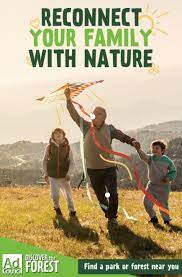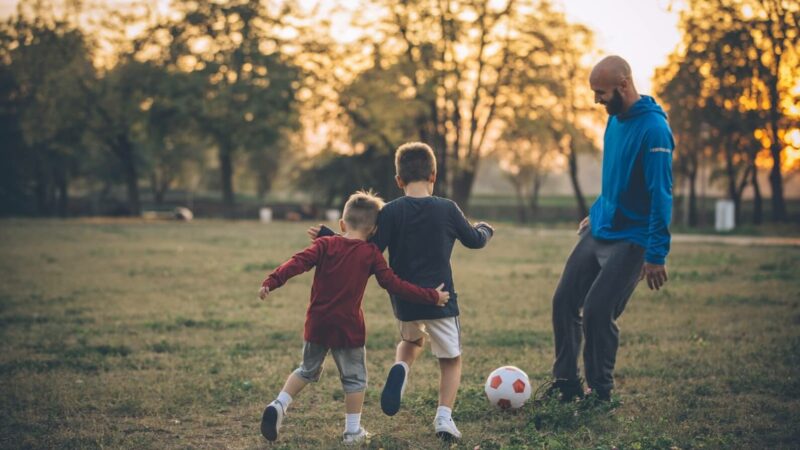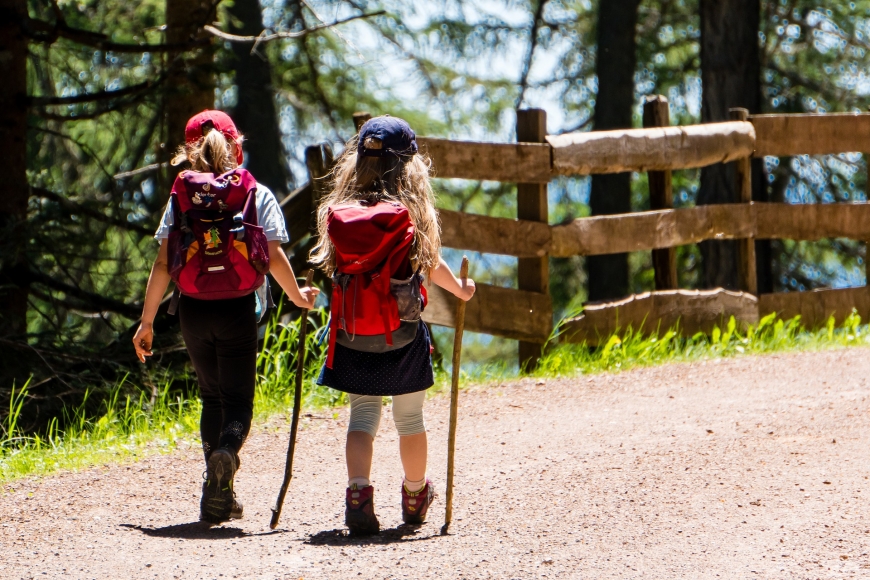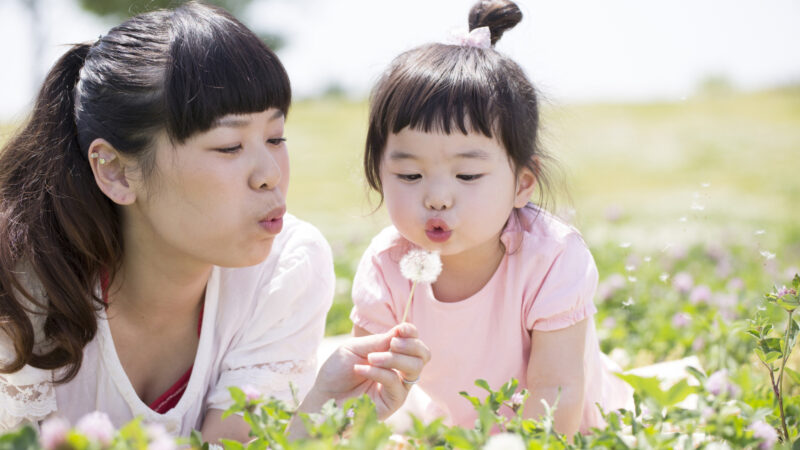
Reconnect with your Family
Some of the best memories are made in nature. Find a forest or park near you and GET OUTDOORS!
www.DiscovertheForest.org

Whether you live in the city or the country, here are a few ways you can help your child
become a nature adventurer.
Take some time to discover the animals and insects that share your neighborhood. What critters live near you? What can you figure out about where they live, what they do, and what they eat? Take a walk around the block or through a local park to look for clues. These might include:
Animal tracks: Look for animal tracks in the dirt, mud, sand or snow. Were they made by a big animal or a small animal? A mammal or a bird? If you find an unusual track, snap a picture and identify it at home using online resources such as NatureTracking.
Creature structures: Hunt for bird nests in trees, in shrubs, or nestled against buildings. What size and shape is it? What materials is it made of? What other creature homes can you find: Squirrel or rabbit nests? Ant hills? Deer dens? Wasp nests? Spider webs? Mouse burrows?
How many bugs can you find in an afternoon? Here are a few places to look:
Rocks: Gently pick up a rock and look underneath. Chances are you will find a few little creatures who have made their home in the cool dirt.
Wood: Hollow logs and fallen branches often become home to all kinds of bug life.
Ponds: Ponds are full of activity — and a great place to use a net to catch, observe, and release insects.
Flowers beds: Many insects, including butterflies and bees, use flowers as a food source.
We’ve all heard bird calls floating through the air, but how many of us can identify which feathered friend is singing? Listen carefully to a bird song with your child, then try to mimic the sound you hear. Look around and see if you can spot the singer. Want to take your birding to the next level? Use the resources at Cornell University’s bird lab – including their free app Merlin – to identify the birds you see and hear!
Some creatures remain largely hidden during the day. After the sun goes down, take a walk around your neighborhood and search for signs of nocturnal animals and bugs. Depending on the time of year and your location, you might see or hear the following:
Crickets
Bats
Foxes
Racoons
Owls
Deer
Mice
Rats
Geckos
Salamanders
Fireflies
Skunks
Hedgehogs
Raccoons
Toads
To expand your child’s experience with animals beyond the neighborhood, plan an outing to a zoo, aquarium, Audubon center, nature center, or farm near you.

March 2020
With busy schedules and alluring electronics inside the home, it is often difficult to give your children the time outdoors you enjoyed as a child.
Encourage your children to watch for wildlife. There is often wildlife at parks including birds, bugs and sometimes larger friends. Children can log the wildlife they see into a notebook, create drawings or take photos.
Go on a scavenger hunt. Work together to create a list of items you could see in a park like a leaf, a pinecone, sand, a swing, a fence etc.
Draw a nature map of your local park. Walk the park and then have your children draw the map of the park including important features and details from your walk.
Picnic in the park. Your sandwich often tastes better when you are sitting in a beautiful park. Bring a blanket and your favorite foods to enjoy the nice weather. Don’t forget to pick up your trash and to recycle.
Walk. Before or after dinner, take some time to walk together as a family. Discuss what happened during the day while getting a little exercise.
Running games. Teach your children to play “Hide and Seek,” “Red light/Green light” or “Red Rover’” Or with keep it simple by establishing a friendly competition running from one side of the neighborhood park to the other.
Create your own Olympic Games. Who has the fastest time running from one tree to another? How many high jumps can you do in one minute? Use the resources in your neighborhood park to create an Olympic Games for your family.
Make art from nature. Press flowers, glitter pinecones or draw part of your favorite park. Bring a little bit of nature back home with you.
Play with dirt and mud. Bring a shovel or even better, use your hands to dig your way to China. Create mud structures and mud pies. Let your children have the opportunity to get really dirty while learning how to play and be creative by themselves.
Watch the clouds. There is nothing better than to spend some time cloud watching in a park on a sunny day. Lie down on the grass and start to identify shapes.
Start a rock collection. Collect all different shapes and sizes, colors and surfaces. Another great way to bring a bit of the outdoors home with you.
Play in your park during the winter. Bundle up and head out to the park with a sled or a trash bag to fly down the hill on snowy days. Make a snowman or snow angels.
Most importantly, keep toys and electronics to a minimum when visiting a park. That goes for parents also; leave the smart phone and paperwork in your purse or car. It is important to teach your children to have down time away from all electronics. It also will decrease your stress to slow down and enjoy nature.

Finding fun ways to keep kids active sometimes requires thinking outside the backyard. With indoor physical play opportunities limited by COVID-19, why not take advantage of a few hikes on local trails before temperatures turn cooler? A trek through the colorful changing leaves to see some new terrain can be especially beneficial to kids.
If you need a reason to inspire your tribe to take to the trail, try nature treasure hunting and starting a new nature collection. Or how about celebrating National Hiking Day on November 17th? Also called Take a Hike Day, the event is all about helping people of all ages get enthusiastic about hiking and learn more about how to protect and preserve America's beautiful national trail system. It's the perfect prompt to break out your trail guide and backpack, and as it turns out, kids reap more than a great workout from hiking -- there's psychological, cognitive, and social benefits on offer, too.
1. Hiking encourages free play
Free play refers to the unstructured, self-led play and exploration kids naturally engage in when left to their own devices. It prompts them to use critical and creative thinking, develop social skills, and refine motor skills, all of which are developmentally beneficial. [Source]
2. Hiking inspires kids to test their limits
Testing boundaries helps children develop both logic and confidence, and it's a normal and important part of growing up When kids hike, they'll have opportunities to test their physical skills and their limits within reasonable boundaries and with adult supervision. [Source]
3. Hiking can boost energy levels
Wondering how to get your sleepy teen's energy levels up a bit? Encourage them to come for a hike, which can boost their levels of alertness, especially if friends are invited along for social time. [Source]
4. Hiking can improve executive function
Executive function describes the skills used to choose priorities, solve problems, make a decision or follow through with a plan. Kids begin to develop these skills in unstructured social situations with others, especially outdoors; hiking can present unique challenges compared to other outdoor play, prompting critical thinking. [Source]
The National Recreation and Park Association’s mission is to advance parks, recreation, and environmental conservation efforts that enhance the quality of life for all people.

Some of the best memories are made in nature. Find a forest or park near you and GET OUTDOORS!
www.DiscovertheForest.org

The good news is that, even in cities and small spaces, we can bring nature into our lives to reap some of the benefits.
PBS for Kids-Parents